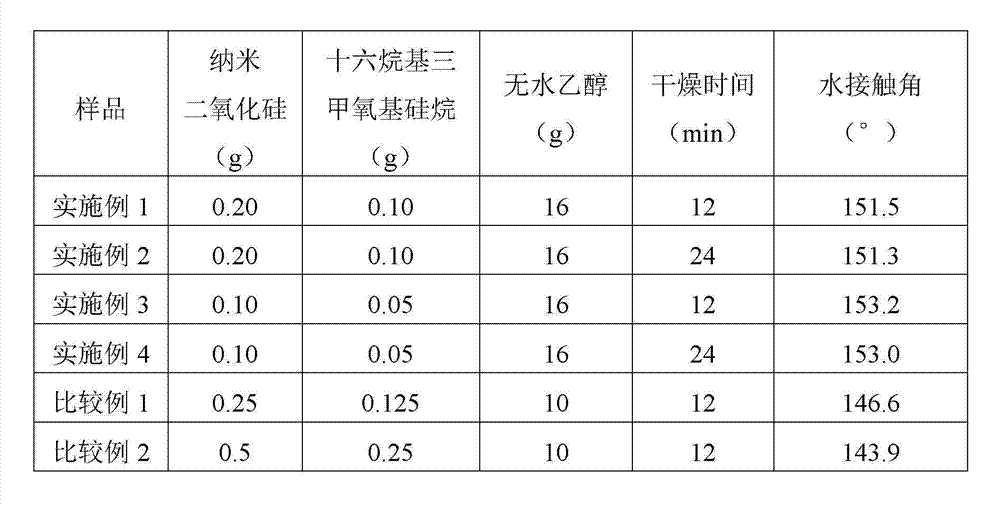Super-hydrophobic paper and production method thereof
A super-hydrophobic paper and super-hydrophobic technology, applied in the field of nanotechnology or bionics, can solve the problems of paper loss of air permeability, no self-cleaning property, complicated process, etc., achieve high commercial application value, stable super-hydrophobic properties, and simple operation process Effect
- Summary
- Abstract
- Description
- Claims
- Application Information
AI Technical Summary
Problems solved by technology
Method used
Image
Examples
Embodiment 1
[0016] Weigh 0.20 g of nano silicon dioxide and add it to 16 g of absolute ethanol, ultrasonicate the resulting suspension for 10 min, then weigh 0.10 g of hexadecyltrimethoxysilane, add it to the above mixture, and ultrasonically for 10 min, A uniform and stable mixture was obtained. Then, the printing paper with text or pictures was soaked in the above mixture for 1 min, then taken out, and dried naturally at room temperature for 12 hours to obtain super-hydrophobic paper. The wettability of the paper surface was tested with a contact angle tester, and the result showed that the water contact angle of the surface was 151.5°. The surface morphology of the paper was observed with a scanning electron microscope, and it was found that a large number of protruding structures imitating lotus leaves were attached to the surface of the paper fibers. See Table 1.
Embodiment 2
[0018] Weigh 0.20 g of nano silicon dioxide and add it to 16 g of absolute ethanol, ultrasonicate the resulting suspension for 10 min, then weigh 0.10 g of hexadecyltrimethoxysilane, add it to the above mixture, and ultrasonically for 10 min, A uniform and stable mixture was obtained. Then, the printing paper with text or pictures was soaked in the above mixture for 1 min, then taken out, and dried naturally at room temperature for 24 hours to obtain super-hydrophobic paper. The wettability of the paper surface was tested with a contact angle tester, and the result showed that the water contact angle of the surface was 151.3°. The surface morphology of the paper was observed with a scanning electron microscope, and it was found that a large number of protruding structures imitating lotus leaves were attached to the surface of the paper fibers. See Table 1.
Embodiment 3
[0020] Weigh 0.10 g of nano silicon dioxide and add it into 16 g of absolute ethanol, ultrasonicate the resulting suspension for 10 min, then weigh 0.05 g of hexadecyltrimethoxysilane, add it to the above mixed solution, and ultrasonically for 10 min, A uniform and stable mixture was obtained. Then, the printing paper with text or pictures was soaked in the above mixture for 1 min, then taken out, and dried naturally at room temperature for 12 hours to obtain super-hydrophobic paper. The wettability of the paper surface was tested with a contact angle tester, and the result showed that the water contact angle of the surface was 153.2°. The surface morphology of the paper was observed with a scanning electron microscope, and it was found that a large number of protruding structures imitating lotus leaves were attached to the surface of the paper fibers. See Table 1.
PUM
| Property | Measurement | Unit |
|---|---|---|
| particle diameter | aaaaa | aaaaa |
| water contact angle | aaaaa | aaaaa |
Abstract
Description
Claims
Application Information
 Login to View More
Login to View More - R&D
- Intellectual Property
- Life Sciences
- Materials
- Tech Scout
- Unparalleled Data Quality
- Higher Quality Content
- 60% Fewer Hallucinations
Browse by: Latest US Patents, China's latest patents, Technical Efficacy Thesaurus, Application Domain, Technology Topic, Popular Technical Reports.
© 2025 PatSnap. All rights reserved.Legal|Privacy policy|Modern Slavery Act Transparency Statement|Sitemap|About US| Contact US: help@patsnap.com

